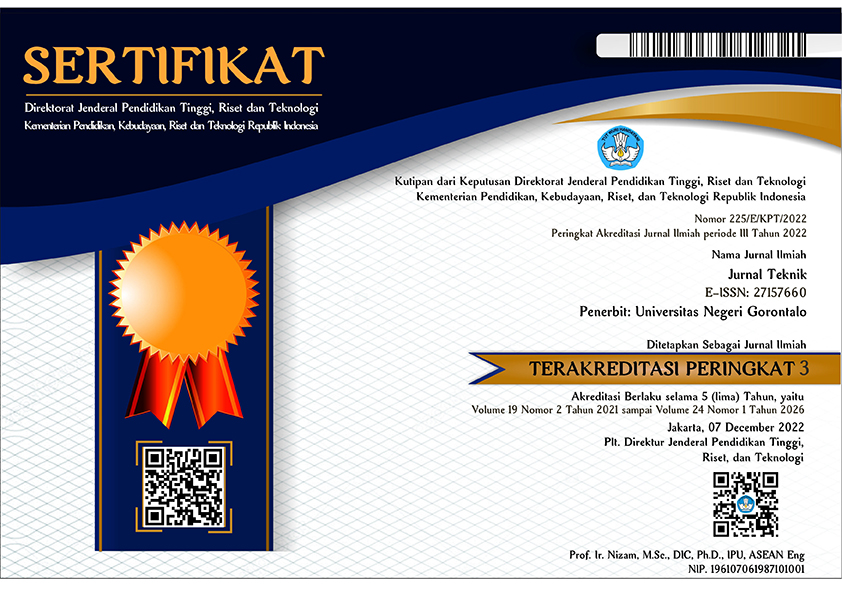Implementation of DMAIC for Production Quality Control: Case Study of Power Supply Production in Indonesia
Abstract
The level of competition in the manufacturing industry is getting tougher, making companies must be able to provide the best service to customers. One of the companies in Indonesia engaged in asset monitoring and ship navigation systems, has a production division that produces power supply products. Based on the analysis that has been carried out at the company that there are problems such as a damaged PCB connector that makes the product categorized as a manufacturing defect. This research aims to be able to find alternative improvements to production processes that have a high defect rate. The Define, Measure, Analyze, Improve, and Control (DMAIC) framework is used as a method to shape the mindset of management and employees to be able to solve these problems. Based on this framework, three causes of the problem were found, namely human factors, materials, and inappropriate methods during the production process. Therefore, appropriate corrective actions are taken, and a control process is carried out by comparing control charts, Defects Per Million Opportunities (DPMO) and sigma levels to determine the impact of changes from the improvements made. Quantitatively, there was an increase in the DPMO value of 39.47% and an increase in the sigma level of 8.64%. This shows that the DMAIC framework can provide the right solutions and preventing the same quality problems from happening again.
Downloads
References
Ai, Z., Heinle, I., Schelske, C., Wang, H., Krause, P., & Bäck, T. (2021). A Classification-based Solution for Recommending Process Parameters of Production Processes Without Quality Measures. Procedia Computer Science, 180, 600–607. https://doi.org/10.1016/J.PROCS.2021.01.282
Boon Sin, A., Zailani, S., Iranmanesh, M., & Ramayah, T. (2015). Structural equation modelling on knowledge creation in Six Sigma DMAIC project and its impact on organizational performance. International Journal of Production Economics, 168, 105–117. https://doi.org/10.1016/J.IJPE.2015.06.007
Deeb, S., Haouzi, H. B. el, Aubry, A., & Dassisti, M. (2018). A generic framework to support the implementation of six sigma approach in SMEs. IFAC-PapersOnLine, 51(11), 921–926. https://doi.org/10.1016/J.IFACOL.2018.08.490
Dias, J. A., Ferreira, L. P., Gonçalves, M. A., Silva, F. J. G., & Ares, E. (2019). Analysis Of An Order Fulfilment Process At A Metalwork Company Using Different Lean Methodologies. Procedia Manufacturing, 41, 399–406. https://doi.org/10.1016/J.PROMFG.2019.09.025
Godina, R., Pimentel, C., Silva, F. J. G., & Matias, J. C. O. (2018). Improvement of the Statistical Process Control Certainty in an Automotive Manufacturing Unit. Procedia Manufacturing, 17, 729–736. https://doi.org/10.1016/J.PROMFG.2018.10.123
Kumar Phanden, R., Sheokand, A., Kumar Goyal, K., Gahlot, P., & Ibrahim Demir, H. (2022). 8Ds method of problem solving within automotive industry: Tools used and comparison with DMAIC. Materials Today: Proceedings, 65, 3266–3272. https://doi.org/10.1016/J.MATPR.2022.05.383
Luo, T., Wu, C., & Duan, L. (2018). Fishbone diagram and risk matrix analysis method and its application in safety assessment of natural gas spherical tank. Journal of Cleaner Production, 174, 296–304. https://doi.org/10.1016/J.JCLEPRO.2017.10.334
Müller, R., Scholer, M., Schirmer, L., & Blum, A. (2020). Tolerance management in robot-based assembly optimizes product, process and system deviations. Procedia CIRP, 93, 1103–1108. https://doi.org/10.1016/J.PROCIR.2020.04.027
Pacana, A., Czerwinska, K., & Dwornicka, R. (2021). Analysis of quality control efficiency in the automotive industry. Transportation Research Procedia, 55, 691–698. https://doi.org/10.1016/J.TRPRO.2021.07.037
Park, C., Ouyang, L., & Wang, M. (2021). Robust g-type quality control charts for monitoring nonconformities. Computers & Industrial Engineering, 162, 107765. https://doi.org/10.1016/J.CIE.2021.107765
Powell, D., Magnanini, M. C., Colledani, M., & Myklebust, O. (2022). Advancing zero defect manufacturing: A state-of-the-art perspective and future research directions. Computers in Industry, 136, 103596. https://doi.org/10.1016/J.COMPIND.2021.103596
Ribeiro, I. M., Godina, R., Pimentel, C., Silva, F. J. G., & Matias, J. C. O. (2019). Implementing TPM supported by 5S to improve the availability of an automotive production line. Procedia Manufacturing, 38, 1574–1581. https://doi.org/10.1016/J.PROMFG.2020.01.128
Samuel, R., Rajesh, M., Rajanna, S., & Franklin, E. (2021). Implementation of lean manufacturing with the notion of quality improvement in electronics repair industry. Materials Today: Proceedings, 47, 2253–2257. https://doi.org/10.1016/J.MATPR.2021.04.200
Senthil Kumar, K. M., Akila, K., Arun, K. K., Prabhu, S., & Selvakumar, C. (2022). Implementation of 5S practices in a small scale manufacturing industries. Materials Today: Proceedings, 62, 1913–1916. https://doi.org/10.1016/J.MATPR.2022.01.402
Shen, Y., Zhou, J., Pantelous, A. A., Liu, Y., & Zhang, Z. (2022). A voice of the customer real-time strategy: An integrated quality function deployment approach. Computers & Industrial Engineering, 169, 108233. https://doi.org/10.1016/J.CIE.2022.108233
Copyright (c) 2023 B. Handoko Purwojatmiko, Laksmi Ambarwati (Author)

This work is licensed under a Creative Commons Attribution-ShareAlike 4.0 International License.













